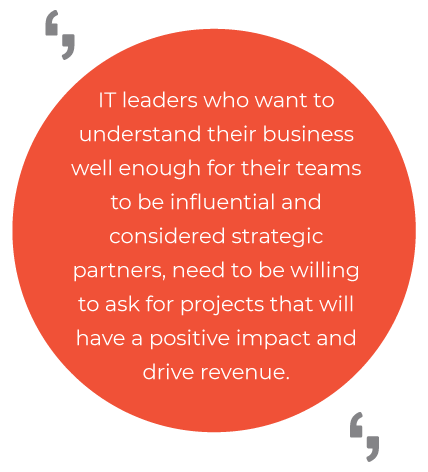For decades, organizations have relied on technology – with IT departments leading the way, managing the essentials like email accounts, websites and applications. Established as its own separate entity, IT has generally never been considered profitable, at least not directly. Rather, they’ve been looked at as cost centers – the price of doing business in a digital world. To add, IT leaders and their teams were often left out of any business discussion (let alone long-term strategies) until a major project or purchase was already underway. And many times, those purchases were never implemented.
Now we’re seeing a 180° spin. Today’s IT departments are no longer about buying, building and managing onsite technology infrastructures and technology delivery – they’ve expanded well beyond these traditional responsibilities and have become more relevant to the bottom line. IT departments are more than necessary expenses, they’re a driver for innovation, providing real competitive advantages and becoming true profit centers – and just as responsible for generating revenue as any sales department.
This change isn’t going unnoticed. According to the data published in the “State of IT” report by Salesforce Research, 75% of technology leaders say IT is currently in the midst of the biggest historical shift ever. Business executives are working hard to figure out how to succeed with innovation – this change is forcing them to reevaluate how they use their IT departments, as well as the roles of those who manage them.
In 2019, organizations depend on technology more than ever before. So business leaders, even if they don’t grasp what they need to do from a technical perspective, want to have an influential role in IT and contribute to their company’s technology vision. They want to invest in IT to sustain and grow their organizations over the long term, with sales growth being the most common measuring stick for success.
But a large number are uncertain about just how to invest and how to connect an innovation strategy with the company’s overall business strategy. Leadership wants innovation, they just often don’t know how to use innovation in the bigger context of the organization. What can they do? A few basic factors set the path for success:
- A clear and aligned vision
- Being educated on trends impacting their industry
- Asking how they’ll use innovation to respond – without this intentional guidance, it’s easy to get off track
Concurrently, CIOs and other tech leaders need to toughen up and capitalize on their new status in the C-suite and sharpen up their leadership and communication skills that many dismiss as unnecessary. Without those skills, they sabotage their IT departments from becoming truly effective. They also need to be proactive and go to business leaders with ideas they can evaluate and refine – before their business counterparts ask for them. The ability to offer IT infrastructure innovations regularly – before the business demands them – protects IT leaders against commoditizing their departments.

People are also more technology-savvy than they used to be in every area of business, so if IT wants to be an influencer at the table, they need to be willing to up their game and bring in people who can add to the technical and operational aspects of their team with financial and business analysis skills. In order to shift from being efficient order takers to partners in determining and knowledge of the overall business, itself, is critical. IT leaders must be willing to invest in and develop employees who are able to gain business insight and effectively explain the IT infrastructure’s value, then work with business leaders to implement it. Smart IT leaders know this. And they’re hiring strategically-minded, forward-thinking problem solvers who can influence innovation across an entire enterprise. More and more, STEM programs reflect this need. One of the ways we hire new employees at Synoptek is through a college-graduate program. Hands down, these new graduates are being taught critical thinking as well as good collaboration and presentation skills before ever receiving their diplomas and flipping their tassels.
So as IT leaders and their teams are given a stake in the business relied upon more and more to contribute to their organization’s outcomes, they also need to be deliberate in redefining their role and the path required for their teams to be successful. We’re talking a true strategic partner – one who sits in on annual planning meetings and ultimately, is trusted to help their business innovate and realize its vision.
This is the trend of IT. In every facet of business, organizations increasingly depend on technology to stay updated and connected with their customers and their co-workers and IT becomes all the more inseparably connected to business strategy – not only as a resource but as a source of continual profit.
Download PDFAbout the Author
Tim Britt is founder and CEO of Synoptek, a Global Systems Integrator (SI) and Managed IT Services Provider (MSP) offering Comprehensive IT Management and Consultancy Services to organizations worldwide. An entrepreneur at heart — Tim leverages technology to squash the status quo and create solutions for his clients — a mission he’s been on for more than 20 years.



